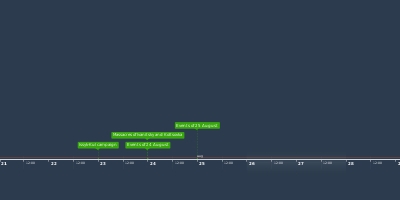Battle of Grand Couronné (20 St. 32 Min, 3 Sept 1914 Jahr – 4 St. 35 Min, 13 Sept 1914 Jahr)
Beschreibung:
The German offensive began during the night of 3 September, against the fortifications of the Grand Couronné, either side of Nancy, which pushed back the 2nd Group of Reserve Divisions with the 59th, 68th and 70th Reserve divisions (General Léon Durand) to the north and the XX Corps (General Maurice Balfourier) to the south, by the evening of 4 September. In the afternoon of 5 September, Castelnau telegraphed to Joffre that he proposed to evacuate Nancy rather than hold ground, to preserve the fighting power of the army. Next day Joffre replied that the Second Army was to hold the area east of Nancy if at all possible and only then retire to a line from the Forest of Haye to Saffais, Belchamp and Borville. The civilian authorities in the city had begun preparations for an evacuation but the troops on the Grand Couronné repulsed German attacks on the right flank during 5 September; the Reserve divisions were only pushed back a short distance, on the front to the east and north of Nancy. An attempt by Moltke to withdraw troops from the 6th Army, to join a new 7th Army being formed for operations on the Oise failed, when Rupprecht and Dellmensingen objected and were backed by the Emperor, who was at the 6th Army headquarters.[6][a] German attacks continued on 6 September and the XX Corps conducted a counter-attack, which gave the defenders a short period to recuperate but the troops of the 2nd Group of Reserve Divisions, east and north of Nancy began to give way.[7]On 7 September, German attacks further north drove a salient into the French defences south of Verdun at St. Mihiel, which threatened to separate the Second and Third armies.[8] At Nancy, part of the 59th Reserve Division retreated from the height of St. Geneviève, which overlooked the Grand Couronné to the north-west of Nancy, exposing the left flank of the Second Army and Nancy to envelopment. Castelnau prepared to withdraw and abandon Nancy but was circumvented by the Second Army staff, who contacted Joffre and Castelnau was ordered to maintain the defence of the Grand Couronné for another 24 hours. (Castelnau had received news that one of his sons had been killed and gave the orders while shocked.)[7] The French abandonment of the height of St Geneviève went unnoticed by the Germans, who had retired during the afternoon and the height was reoccupied before they could react. German attacks continued until the morning of 8 September, then diminished as Moltke began to withdraw troops to the right (west) flank of the German armies. Moltke sent Major Roeder from his staff to the 6th Army, with orders to end the offensive and prepare to retire to the frontier; only at this point did Rupprecht find out that the armies near Paris were under severe pressure. On 10 September, the 6th Army began to withdraw to the east.[9] On 13 September, Pont-à-Mousson and Lunéville were reoccupied by the French unopposed and the French armies closed up to the Seille river, where the front stabilized until 1918.
Zugefügt zum Band der Zeit:
Datum:
20 St. 32 Min, 3 Sept 1914 Jahr
4 St. 35 Min, 13 Sept 1914 Jahr
~ 10 days
